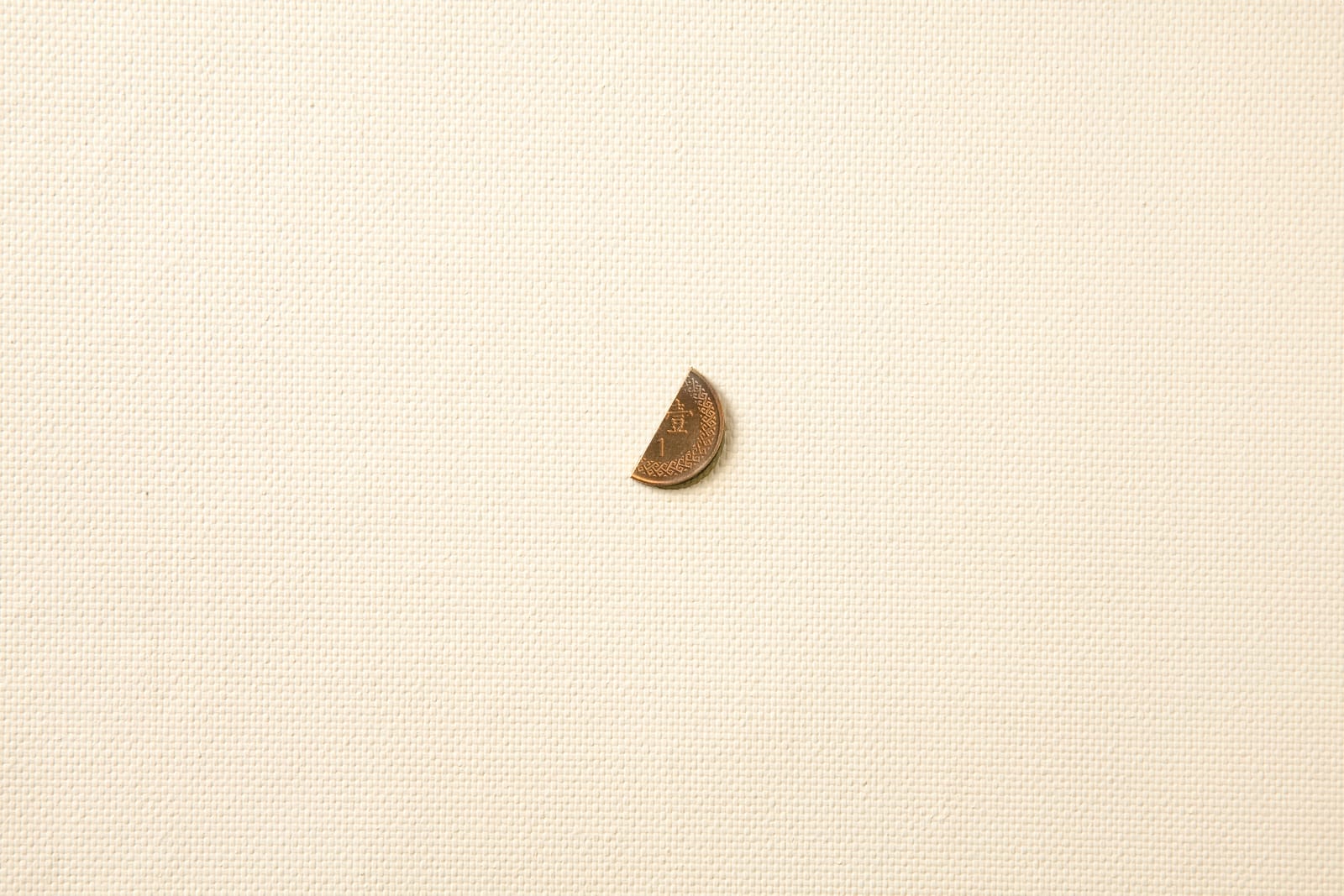 “Fifty Cents” 〈伍毛〉
“Fifty Cents” 〈伍毛〉
 “Fifty Cents” close-up details
〈伍毛〉局部特寫
“Fifty Cents” close-up details
〈伍毛〉局部特寫
 Exhibition contract of “Fifty Cents”
〈伍毛〉展覽合約
Exhibition contract of “Fifty Cents”
〈伍毛〉展覽合約
 Process photograph 過程影像
Process photograph 過程影像
 Process photograph 過程影像
Process photograph 過程影像
 Process photograph 過程影像
Process photograph 過程影像
 25 cents worth of bread crumbs
價值兩毛五的麵包屑
25 cents worth of bread crumbs
價值兩毛五的麵包屑
 Installation view
展場照
Installation view
展場照
Shi Jin-Hua
45 x 105 cm (“Fifty Cents” document)
42 x 38 cm (breadcrumb images on porcelain plate)
7′ 01″ (video)
42 x 29.7 cm (document)
Further images
-
(View a larger image of thumbnail 1
)

-
(View a larger image of thumbnail 2
)

-
(View a larger image of thumbnail 3
)

-
(View a larger image of thumbnail 4
)

-
(View a larger image of thumbnail 5
)

-
(View a larger image of thumbnail 6
)

-
(View a larger image of thumbnail 7
)

-
(View a larger image of thumbnail 8
)

-
(View a larger image of thumbnail 9
)

In the beginning of 2009, I was yet again invited by a gallery to participate in a joint exhibition which showcased artworks priced at under NTD30,000. I incised a one-dollar coin in half, and glued one of the halves on a white canvas. The canvas was framed and priced at fifty cents. The piece was named Fifty Cents, and bought by an art critic. According to the norm in Taiwan, the artist and the gallery split the pay 50/50 for the artwork, which means the artist and the gallery would each receive 25 cents.
Nevertheless, the gallery faced a great challenge in paying me my share, since the smallest value of coins in Taiwan is only 50 cents. The gallery told me, “We are not unwilling to pay you, it’s just that 25 cent coins are simply not available.” Since it seemed like the gallery was about to default, we had to negotiate the terms. I suggested that the gallery pay me with bread from Uni-President convient store. So with the help of an electric scale, I was paid with breadcrumbs that valued exactly 25 cents. The negotiation between the gallery and I was documented, while the process of cutting and weighing the bread was all videotaped and produced into documents for display, which became the Art Income.
In terms of the artwork Fifty Cents, I was trying to debate the relationship between the object and the concept, symbols and currencies, artwork and its relationship to aesthetics and market value. So, “Does one half of a physical coin equate to one half of its symbolic value and the market value?” “When a coin becomes an object of art, how is the new price and value set?” Coincidence or not, incising a coin into two symbolizes giving the gallery a 50% commission , which is the norm in the contemporary art circle that the artist wants to implicitly highlight.
The piece Art Income, an extension of Fifty Cents, is a conceptual piece about “exchange” and “income.” In the old days, we exchanged goods for goods. Men moved on to using shells as currencies, and ended up using money as a means of exchange. I am not sure whether art could be understood or comprehended. However, objects of art could definitely be exchanged. In fact, it is this kind of “spiritual materialism” that makes the world of art go round. In the Fifty Cent case and the default incident, the artist proposes an ancient solution, which is to substitute money with breadcrumbs and solved the problem of not being able to divide fairly the payment. What is better is that “bread” and “crumbs” both serve as metaphors for the artist’s “demand” and “income.”
Fifty Cents could symbolize artwork in general. Many of the times, artists’ efforts and investment far exceed the priced value of the work. Fifty Cents was priced at 50 cents, yet the costs for the materials, framing, and insurance coverage went thousands of times beyond its price. In the art market, it usually is that art material suppliers, framing professionals and transportation service providers gaining the most financially, while most galleries are struggling to survive, and artists having a hard time putting bread on the table. In the end, those that gain the most out of art are usually the final owners of art works (collectors, agents, and investors).
2009年年初,我再次接獲畫廊邀請參加3萬元以下作品的聯展。我將一個壹元硬幣切成一半,以膠水黏貼在畫布上,然後裝框,定價5毛,送去參展。顧名思義,這件作品就叫〈伍毛〉,最後被一位藝評家買下。依照台灣藝術界的一般慣例,展覽合約載明售得款的分配比例為五五分帳,畫廊與藝術家對分各得2毛5。
由於台灣流通最小的幣值是5毛,畫廊無法支付這個金額給我,他們說:「不是不給你,是給不出2毛5。」在違約的狀況下,雙方勢必將進行協商談判。我建議以統一超商的麵包做為交換,解決雙方之帳務僵局。於是,畫廊在精密電子秤的幫助下,切出價值2毛5的麵包屑給我。整個談判協商、切麵包、秤麵包的過程,都製作成〈藝術所得〉的錄像與影像文件。
單就〈伍毛〉這件作品來說,藝術家在這裡提出思辨的問題是關於物體與觀念存有,符號與幣值體系,藝術品與美學價值、市場價格之間的關係。究竟「硬幣物理上的二分之一,會不會等同於硬幣符號與貨幣價值的二分之一呢?」「當硬幣變成藝術物體後,新的價值與價格又是如何產生的呢?」不論是巧合或準確,將硬幣切成一半的動作與出售後五五分帳的契約內容,正是藝術家想要隱喻的當代藝術商業慣例。
至於由〈伍毛〉引出的作品〈藝術所得〉,則是一件關於「交換」與「所得」的觀念性作品。古時候,我們先是以物易物,後來以貝殼易物,如今我們以貨幣做為交換的基準與憑藉。藝術是否能為人體會與理解我並不知道,但藝術的物體肯定是可以交換的,事實上就是這種「精神的物質主義」才是究竟讓藝術地球自轉的根本動力啊。在這場〈伍毛〉引發的違約事件中,藝術家提出一個復古的解決方案,以物易物的「交換」金錢與麵包,有效地且公平地解決利益無法均分的紛爭。美妙的是,「麵包」與「麵包屑」,準確隱藝術家的「所求」與「所得」。
〈伍毛〉在此可以廣泛代表所謂的「藝術作品」。很多時候,藝術家創作的付出與成本,遠遠超過藝術的定價與所得。〈伍毛〉定價5毛,而其材料、裝裱運輸與保險費用卻是定價的數千倍!整個藝術商業運轉機制中,肯定獲利的是美術用品商、裝裱與運輸業者,多數畫廊經營得很辛苦,藝術家交換得到的只是維生的麵包,而最後最大藝術所得的獲利者是藝術品的持有者(藏家、畫商、投資客)。
Exhibitions
2014 “Unceasing Reincarnation”, Show Gallery, Kaohsiung, Taiwan
2010 “Taipei Biennial”, Taipei Fine Arts Museum, Taipei, Taiwan2010 “The Trilogy of Contemporary Art Alchemy”, Inart Space, Tainan, Taiwan
2010 “Contemporary Art Alchemy: Shi Jin-Hua”, Nou Gallery, Taipei, Taiwan
2014「浮生未歇」,小畫廊,高雄,台灣
2010「2010台北雙年展」,台北市立美術館,台北,台灣2010「當代藝術煉金術三部曲」,加力畫廊,台南,台灣
2010「再展石晉華 當代藝術煉金術」,新畫廊,台北,台灣
Publications
2013 “Shi Jin-Hua”, Mind Set Art Center, Taiwan2013 《石晉華》,安卓藝術股份有限公司,台灣
